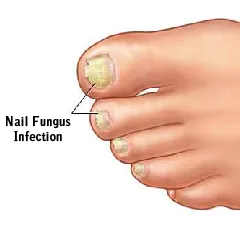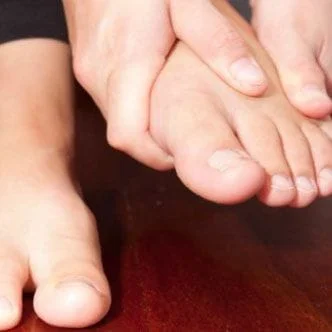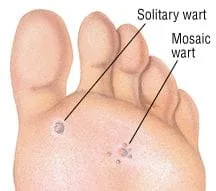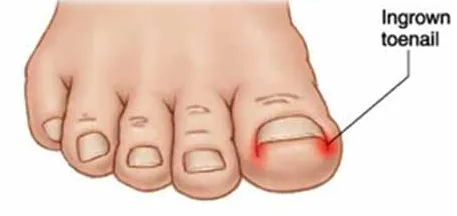We offer a variety of nail and skin care services to treat our valued patients. We encourage you to learn more about what we provide and how we can help. If you have any questions, please contact us by calling (954) 437-0200. We're always happy to hear from you!
- Fungal Nails
- Skin Cancer
- Warts
- Repeated HPV exposure. For example, walking barefoot in public locker rooms and common public areas.
- Having a weakened immune system.
- Athlete's Foot
- Ingrown Toenails
- Calluses & Corns

FUNGAL TOENAILS
MANY TOENAIL FUNGUS TREATMENT OPTIONS, INCLUDING MEDICATION & LASER
Do you have thick, yellow, discolored toenails? Are you embarrassed to wearyour open-toed shoes in public? Chances are you have fungal toenails, a condition also known as onychomycosis.
Fungal toenails are caused by an organism that growsin and under the nail. The fungus likes to grow in warm, moist places like your shoes. Many patients pick up fungal toenail infections in the gym locker room, from a nail salon, wet shoes or from trauma. Fungus can stay in the nails for many years and can be passed from one person to another.
Treatment for fungal toenails includes topical and oral medications, which used together are very effective. If you're tired of looking at those unsightly toenails, don't delay wearing open toe shoes schedule an appointment today.
Concerned about SKIN CANCER? CHECK YOUR SOLES

Here at Podiatric Associates, your podiatrists are uniquely trained as lower extremity specialist to recognize and treat abnormal conditions on the skin of the lower leg and feet. Your podiatrist will investigate the possibility of skin cancer both through clinical examination and with the use of a skin biopsy. This is a simple procedure where a small sample of the skin is taken and sent to a specialized laboratory where a skin pathologist will examine the tissue in greater detail. For this reason, our knowledge and clinical training is of extreme importance for patients for the early detection of both benign and malignant skin tumors.
Don't put yourself at risk by ignoring these signs. Schedule a consultation so that we can safeguard you against the cancers and complications that could develop.

What Are Plantar Warts?
Plantar warts are caused by the human papilloma virus (HPV) invading the body through the skin on the bottom of the feet, typically through cuts or breaks. The virus often is present on contaminated surfaces, such as the tile floors of public locker rooms, showers, and swimming pools.
Some individuals are more prone to the virus that causes plantar warts than other people. Risk factors include:
When first diagnosed, individuals often feel a “lump” on the bottom of the foot when standing,similar to having a stone in their shoe. If left untreated, plantar warts can grow up to 1 inch in circumference and may spread into clusters (called mosaic warts). In severe cases, they cause a change in gait or posture that results in leg or back pain.
If you suffer from plantar warts, schedule an appointment with our practice. We can diagnose and treat your warts to remove them fast, and advise you on how to protect against them in the future.

How Do I Know It’s Athlete’s Foot?
Athlete’s foot often first appears as an itchy red rash, typically beginning between the fourth and fifth toe. If left untreated, the skin may become highly sensitive to the touch. If allowed to progress, the condition can result in white, peeling skin.
It is important to treat athlete’s foot at the first sign of infection, as the body can become vulnerable to other bacterial infections when large cracks occur in the skin. The infection can also be transmitted to other parts of the body through bedding and clothes. Patients with serious cases of athlete’s foot may develop a rash that covers the sole of the foot. Known as “moccasin foot,” this manifestation of athlete’s foot creates extremely scaly, thick and rough skin on the bottom of the foot.
Athlete’s Foot Treatment
There are antifungal athlete’s foot treatments available over the counter, but it can benefit you to have your condition diagnosed by your trusted podiatrist first, especially if it has come back a few times.
If you think you have athlete's feet, schedule an appointment with our foot specialist and let us help you find relief.

Ingrown toenails are a long-lasting and quite painful condition. Its appearance is a toenail grown into the finger's flesh, into the corners or sides of the skin. Many different things cause ingrown toenails, from incorrectly cut toenails, to wearing tight shoes, injuries, sweaty feet...Also, this condition is sometimes predetermined with the natural shape of the toenails.
Treatment for ingrown toenails is performed by gently numbing the toe, and then removing the offending corner of the nail. If you have chronic ingrown toenails, we can remove the root in the office to permanently prevent re-growth of the ingrown portion of the nail.
If you have an ingrown toenail, don't be afraid to come in. Your treatment will be gentle and virtually painless, and we'll get you back to your normal activities right away.
If you have a pre-existing condition, such as diabetes, you should see us at the first sign of an ingrown toenail. Whatever you do, do not attempt to cut the nail free on your own! This can worsen the infection, or create one where there wasn’t one before.
If you have an ingrown toenail, don't be afraid to come in. Your treatment will be gentle and virtually painless, and we'll get you back to your normal activities right away.

When corns and calluses develop, however, there can often be an underlying issue. When the long bones in the middle of the foot carry more weight than intended, a callus may form on the ball of the foot. A hammertoe can cause corns by rubbing skin against the shoes or between the bones of the adjacent toes. Corns between the toes are called “soft corns” because they retain moisture and do not get hard. Sometimes a small, inflamed, reddish pouch may develop that becomes more painful than the corn. This pouch is known as a bursa.
Treatment options depend on the symptoms you have and whether you have any associated foot deformity. When corns and calluses are causing only mild discomfort, the simplest solution is to try wider, more comfortable shoes with adequate room for the toes to move. These may include lower heels, softer leather, wider toe boxes, or even gym shoes. Gently using a pumice stone to thin any corns or calluses may provide some relief from symptoms. Never use a medicated corn pad or corn-removing product, since these contain a strong acid that cannot differentiate between normal and thickened skin. This can lead to a chemical burn or an open sore that can become infected.
When these treatment options are no longer providing the comfort you need, we advise a consultation with our podiatrist to discuss other treatments.

